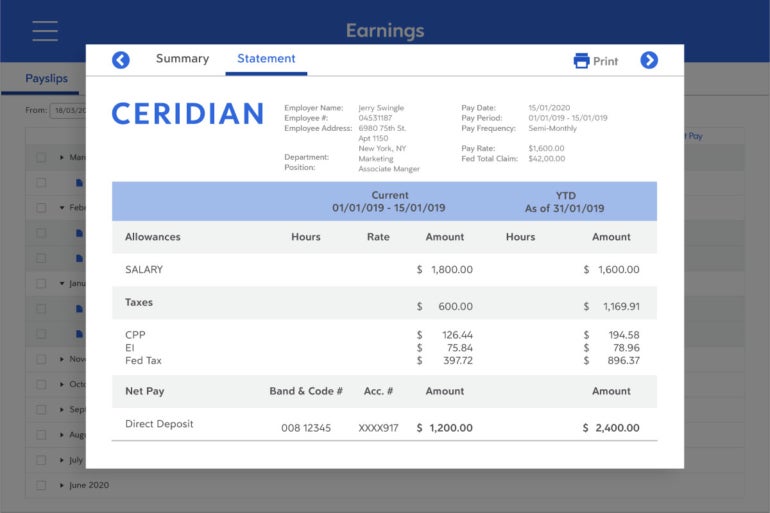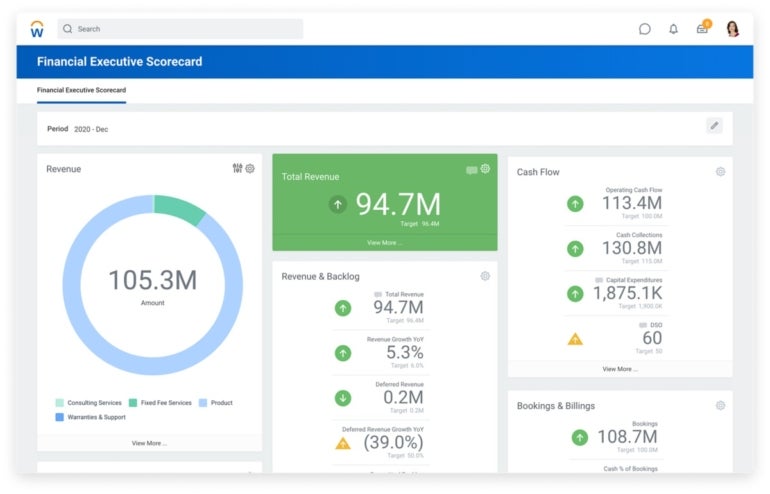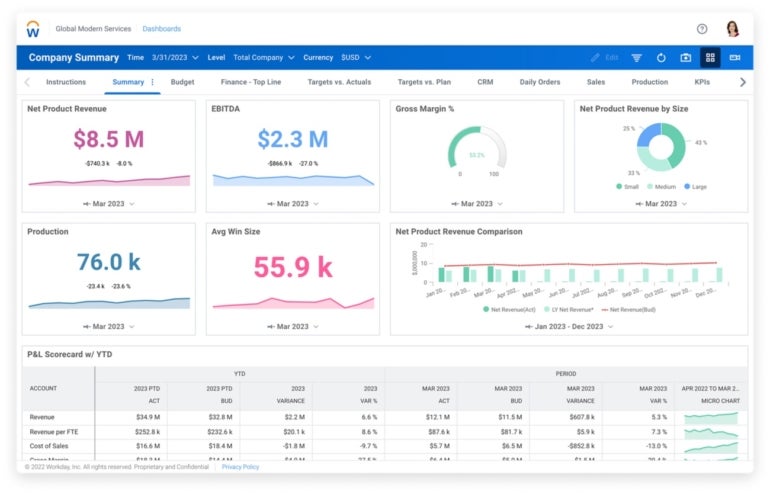
Both Ceridian Dayforce and Workday are cloud-based human capital management (HCM) platforms that are designed for large businesses and enterprises. While many of their features overlap, there are also some key differences that set Ceridian Dayforce and Workday apart from one another. In this guide, we compare and contrast Ceridian Dayforce vs. Workday to help you make the right choice for your business.
Jump to:
Dayforce is enterprise-level human capital management software offered by Ceridian, which is why you might sometimes see it called Ceridian Dayforce. Dayforce encompasses payroll, HR, benefits administration, talent acquisition and management, performance management and workforce management. It can be accessed via a web browser and is also available as iOS and Android apps.
Workday is a suite of cloud-based enterprise software that encompasses payroll, HR, benefits administration, talent acquisition and management, performance management, workforce management, financial planning and operations planning. It can be accessed via a web browser and is also available as iOS and Android apps.
SEE: Oracle vs Workday: A Comparison of HR Software
| Features | Dayforce | Workday |
|---|---|---|
| International payroll | 160+ countries | 4 countries |
| Benefits administration | Yes | Yes |
| Talent acquisition and management | Yes | Yes |
| Performance management | Yes | Yes |
| Workforce management | Yes | Yes |
| Financial planning | No | Yes |
| Operations planning | No | Yes |
Ceridian Dayforce does not currently disclose pricing information on its website. To get a pricing quote, you must contact the sales team. Take a look at our full Ceridian Dayforce review for more information.
Workday also doesn’t disclose pricing information on its website right now, so you’ll have to contact the sales team for a quote. Check out our full Workday review for more information.
Winner: Both
Dayforce’s native payroll platform is available in over 160 countries, making it a great choice for international companies. Dayforce uses a single system to track time and administer pay, and pay information automatically updates through the period as time is tracked (Figure A). Employees can also use the prepaid Dayforce Waller debit card to access their wages early if needed.
Figure A
You can run payroll yourself, work with a managed payroll partner or totally outsource it through Workday. However, Workday’s native payroll platform is only available in the US, Canada, the UK and France. If you need to pay employees in other countries, Workday partners with ADP — one of the biggest global payroll providers — so you can still pay international employees through them. Read our ADP review to learn more about its international capabilities.
Winner: Workday
In Dayforce, employees can use the self-service benefits administration portal to make selections during open enrollment. Compensation management tools ensure that budgets are allocated efficiently, while employee engagement tools help management collect survey responses from workers and turn them into actionable insights.
Workday also provides a whole host of HR software features. Get ready for open enrollment with benefits administration, manage employee raises and bonuses with compensation management and deliver a personalized employee experience with machine learning features. Workday also offers an employee engagement feature called Peakon Employee Voice (Figure B) that helps you gather feedback and retain employees.
Figure B

SEE: SAP vs. Workday: Which Software Is Better for Your Business in 2023?
Winner: Ceridian Dayforce
Dayforce lets candidates create a profile and apply for a job in just five simple steps (Figure C). It also provides screening tools and AI candidate scoring and matching to speed up the hiring process. Once new employees have been onboarded using Dayforce, they can collaborate with their managers to set goals and track their performance on the software. Ceridian Dayforce also offers the Ideal Talent Marketplace to connect employers with flexible on-demand workers to fill scheduling gaps.
Figure C

In Workday, you can manage the full talent lifecycle, starting with native recruiting software that helps you boost the quality of your applications, personalize job searches and make the application process easy. Once employees are hired, Workday provides performance management and training tools, like Workday Skills Cloud, to help your workers continually improve.
Winner: Ceridian Dayforce
With Dayforce, you can use mobile geofencing to track employee’s time, record punch-ins and punch-outs with biometric fingerprint scanning and track attendance patterns over time with reporting insights. Its scheduling tools (Figure D) help managers forecast labor needs, automatically generate a best-fit schedule and share employees across locations or job roles.
Figure D

Workday’s workforce management tools are powered by automation to cut down on repetitive work. Its scheduling tools automatically incorporate new labor laws to ensure compliance. Time and attendance tools let employees clock in and out, trade shifts with coworkers and request time off through the self-service portal.
Winner: Workday
Workday has a dedicated financial planning function (Figure E) with embedded AI to improve budgeting and forecasting processes. Its financial management features translate business data into accounting and provide always-on auditing to help you get ahead of issues. Meanwhile, the spend management function incorporates sourcing and procurement information into one system to streamline decision making.
Figure E

Since Dayforce is more focused on HCM features exclusively, it does not offer this level of dedicated financial planning and management function.
Winner: Workday
Operations planning (Figure F) is the other core non-HR function that Workday offers besides financial management. Workday covers sales planning, demand and supply planning, project planning and marketing planning to help users make smarter business decisions based on data. Workday also offers some other operational tools, including professional services automation and supply chain management for healthcare.
Figure F

Similar to financial management, Dayforce does not offer operations planning features, so you’ll need another platform for that.
SEE: Paycom vs Workday: Which Software Is Better for Your Business in 2023?
To compare Dayforce vs. Workday, we considered several features:
We also weighed other factors, such as:
While writing this review, we consulted product documentation, user videos and demo videos.
Both Dayforce and Workday are designed with larger businesses in mind. Dayforce is best suited for truly enterprise businesses with 1,000 or more employees that are looking for a comprehensive HCM platform. It is also designed for large businesses, but its ease of use makes it a good fit for companies with 250 or more employees. Either tool will be overwhelming (and likely too expensive) for small or midsize businesses.
Dayforce offers some features that Workday doesn’t, such as the Ideal Talent Marketplace. The same can be said of Workday, however, which offers dedicated financial planning and operations planning tools that Dayforce does not. Dayforce is more focused on HCM features only, while Workday also branches out into these additional functions. If you want one tool that does it all, Workday is the better choice.
Dayforce’s global payroll platform is also available in far more countries — over 160 locations — compared to Workday, which supports only four countries. On the other hand, if you only need payroll in those four countries or don’t mind partnering with ADP for other international countries, Workday might be a good choice for you.
Still not sure if either Dayforce or Workday is a good fit for your needs? See our list of the best payroll software for enterprises to broaden your search.